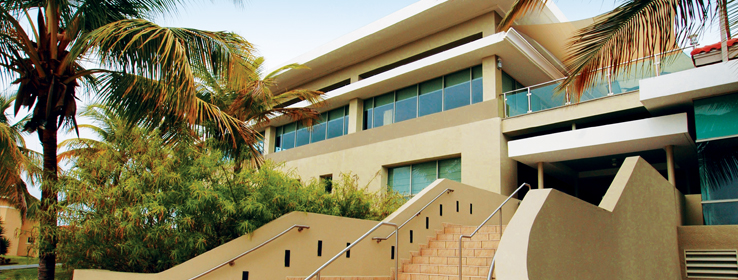On any vertical concrete or masonry surface protection project, looks can be deceiving. That's why it's critical to take extra time upfront to carefully evaluate substrate surfaces — and their overall condition — before you apply new coating. Let's look at three scenarios.
"Over the years, I've seen a tendency for people to take shortcuts by not adequately removing existing substrate coatings, or just painting over surface damage and other structural defects," says Larry Mroz, business development manager for the Sherwin-Williams Concrete Products group. "Remember, the quality of any coating project always begins with a sound, clean surface."
Recommended concrete repair and protective products
Here's a sampling of Sherwin-Williams repair and protective products that can deliver great results for stucco, precast concrete and brick substrates.
Stucco
Recommended coating: Loxon XP® Waterproofing Masonry Coating
Looking for exceptional protection against wind-driven rain and other harsh elements? Loxon XP Waterproofing Masonry Coating requires no priming, meets the most stringent VOC regulations and delivers high-build performance in one coat. It bridges hairline cracks and provides great color retention.
Precast concrete
Recommended patching material: H&C® Quick Patch & Repair
Use this patching compound on above- or below-grade surfaces. It applies easily, sets up fast and cures to produce a bond stronger than surrounding concrete.
Recommended primer: Sherwin-Williams Loxon® Conditioner
This primer's patented acrylic formula offers exceptional resistance to alkali, excellent adhesion and fast cure time.
Recommended protective coating: Loxon XP® Waterproofing Masonry Coating
This product delivers ultimate protection for concrete and masonry surfaces against rain, alkali and efflorescence.
Brick
Recommended protective sealer: Sherwin-Williams Loxon® 40% Silane Water Repellant
When the job calls for complete protection from water, this high-performance coating product delivers. Loxon 40% Silane protective coating easily penetrates masonry and concrete surfaces to seal out damaging moisture and chloride.
Substrate evaluation requires strong attention to detail. While some coatings (such as paint) are obvious barriers to closer surface inspection, a clear sealer may be nearly impossible to detect. When a vertical surface seems bare, Mroz suggests dripping a small amount of water onto the wall. If it doesn't absorb in less than a minute, the surface most likely has a previous seal coat that needs to be removed.
Vertical surfaces present special preparation and repair challenges. For example, acid etching is not recommended due to application difficulty and spillage concerns. Similarly, it's wise to avoid mechanical grinding, largely due to the risks of silicosis (a respiratory disease caused by silica dust). In rare cases, sandblasting may be a viable option for surface preparation, but that approach requires specialized safety and environmental equipment. On the repair side, structural defects such as concrete cracks are best handled with products that can maintain flexibility, such as a polyurethane sealant. For larger patching repairs, consider using an elastomer acrylic compound, which is tough enough to hold a concrete fix without becoming brittle.
Three surface evaluation scenarios
What are some common vertical substrate evaluation and defect repair scenarios? Let's take a closer look:
Stucco. When dealing with stucco, first evaluate the surface for any existing clear or paint coatings. If those exist, Mroz recommends removal via pressure washing (minimum 3500 psi). If that's not enough, he says blasting a mixture of baking soda and water is the next best alternative to clean and abrade a stucco exterior. Once the substrate is free of any coatings, look for structural defects (such as loose or delaminated stucco), which must be chipped out and replaced with fresh stucco before a protective coating can be applied.
Precast concrete. Unlike stucco, which often has a noticeably rugged texture, this commonly used exterior material typically has a smooth finish. Like stucco, the best methods for removing any existing coatings are either high-velocity pressure washing or a soda blast. After the surface has been cleaned, Mroz again recommends a careful inspection. Look for cracks, exposed rebar or delamination caused by steel corrosion. If such surface problems exist, remove the damaged substrate and apply an anticorrosive agent before using concrete patching material. Then, apply a surface primer and finish up with two coats of a protective coating.
Brick. Brick can vary widely in terms of surface texture, and it can occasionally have clear protective or other decorative coatings. To ensure a good visual inspection of the substrate, use high-velocity pressure washing to clean and remove any residual overlay. According to Mroz, all brick substrate must be checked for at least two potential structural defects. First, examine the surface's overall condition, looking for spalling or large cracks. Second, check the mortar joints, where time or environmental conditions may have taken a toll. If you discover problems in either area, you must make repairs before applying a protective coating. In most cases, you can use a clear penetrating sealer, which retains the brick's natural appearance.




